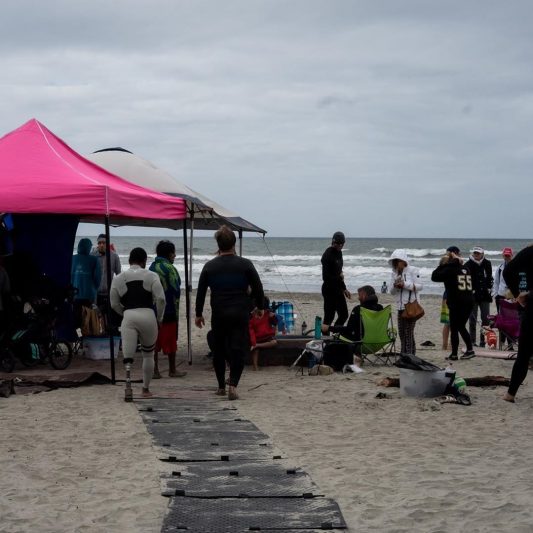Whether you are headed to the beach, the park, camping in the mountains, or just in your yard, there are many different ways to use pathway support tracks. In this blog, we will be going over 6 common uses of pathway support tracks. Not only will we explore common uses, but also discuss the best way to implement them in each case.
Sand Trekking
As mentioned in this previous blog post, pathway support products are perfect for trekking across the sand. Since sand is a variable surface, sometimes assistance is required to trek across it. For example, sand that is closer to the water or graded, is a relatively stable surface. However, non-graded or soft sand easily shifts when trekking across it. The best way to use a support track in this scenario, would be to grade the sand. Another tip would be to stake down the pathway support tracks so they are less likely to shift.

Adaptive surfers seen here trekking across the sand at at a Waves4All adaptive surf session
Uneven Terrain Solution
Another common use for pathway support tracks are on uneven terrain. Similar to sand, uneven terrain can include gravel, rocks, snow etc. The solution for setting up on these uneven terrains can vary. For example, on gravel and rocks, you may be unable to use stakes because the ground is too hard. However, if the pathway is as well-designed as Access Trax, then there should no issue on these types of surfaces even without stakes. Just like with sand, it is possible to stake down when using on snow. One important thing to remember is that it’s important to keep the surfaces of the pathway relatively dry to prevent slipping.
Muddy Surfaces
A third common use for pathway support tracks are on muddy surfaces. Since the wheels of standard wheelchairs can easily get stuck in the mud, it is a perfect solution. One important tip for using a product like Access Trax on muddy surfaces is to keep the top of the pathway relatively clean by sweeping. This will not only prevent issues from traversing the pathway, but will also keep wheels, shoes, and feet cleaner.

Attendees at the Zappos adaptive fashion show easily avoid muddy surfaces and thick grass
Grass Land
Another common use of pathway support tracks are on the grass. Although grass may not be difficult for most pedestrians, people who use wheelchairs can sometimes get stuck. It can require a lot of physical effort to propel a wheelchair or other wheeled device through grass. A support pathway such as Access Trax has no problem turning a grass surface into the equivalent of a solid sidewalk. Using stakes in grass is not only easy, but will secure the pathway firmly so that there is no shift.
Pedestrians
One of our favorite uses for a pathway support track is for pedestrians on the sand. Depending on the time of day, the sun can heat up the sand so that it is too hot for pedestrians. The alternative is to wear shoes, but who wants to do that while trekking on the beach. The best solution is to lay down a product like Access Trax. This is a tried and true method and a lot of customers find that this is a hidden feature when using a pathway on the sand.

Volunteers help setup Access Trax at a Stoke For Life Event
Home Outdoor Vicinity
The last common use for pathway support tracks is to use them outside of your home. Many homes have gravel driveways, cobblestone pathways, and uneven ground. We have already discussed these types of surfaces above, so there is no need to go into more detail. However, it is valuable to use a pathway such as Access Trax outside your home to enhance accessibility where there are any uneven surfaces. Many of our customers rent Access Trax when they are having an event at their house such as a birthday party or family gathering.





What kind of stakes would I use for grass to secure beach trax?
Thank u
Hi Catherine! Great question. It depends on the depth of the grass, but we typically recommend galvanized steel stakes such as these: Flathead Spikes
The spikes simply need to be less than 1/2″ in diameter with a head that is more than 1/2″ in diameter so it does not slip through. We hope this helps! If you have any other questions please feel free to email us at accesstrax@gmail.com.